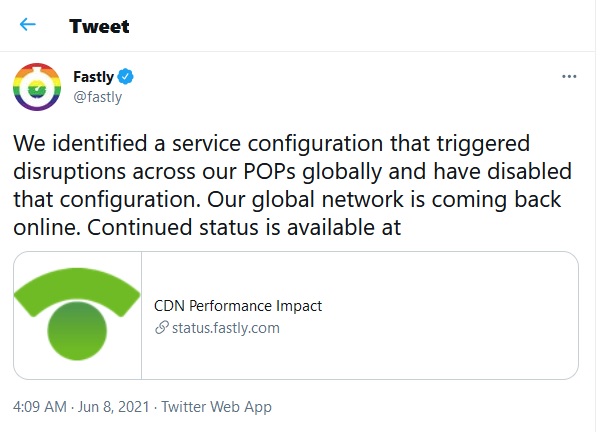An hour-long outage this Tuesday ground the Internet to a halt after popular Content Delivery Network (CDN) provider, Fastly, experienced a glitch that downed Reddit, Spotify, HBO Max, Shopify, Stripe and the BBC, to name just a few of properties affected.

The error brought down everything from streamers to fintech to news outlets, but fortunately only lasted about an hour, with Fastly calling the issue a "global CDN disruption," indicating that it wasn't relegated to issues at a single data center.
While this outage was frustrating for users who logged on Tuesday morning only to be greeted by a 503 error, it likely had many non-IT folks curious about CDNs and the larger Internet Infrastructure delivering their apps, sites and workflows (at least for an hour). While IT teams understand CDNs and their role in the business-critical apps employees consume, this type of outage highlights the need for end-to-end visibility.
For starters, CDNs are a critical component of the larger Internet. CDN companies operate servers around the globe that connect to improve performance and availability of web services by caching some data as close to the end user as possible. With apps now critically linked to business tasks and productivity, the most popular apps use CDN technology to provide a consistently good experience for all users. For instance, the media content you consume (ie. your New York Times front page) may be cached at a CDN server near you so that it doesn't have to be retrieved from a far-flung server every time you load a web page.
So while a page could take hundreds of milliseconds to load when it's being retrieved from a server on the other side of the world, a CDN can usually start sending the content of a page in less than 25 milliseconds when it's already been cached. This, in part, is how apps have continued to grow more complex without impacting the responsiveness for the end user.
Another way to understand CDNs is in relation to edge computing: in many enterprise contexts, CDNs are the WAN edge.
To help avoid congestion at key points in the network, teams can employ subnets (or VLANs) to help segment traffic at key locations, which can more intelligently (and predictably) route traffic to reduce the load on the larger network. In a similar fashion, enterprises can deploy CDNs that serve external requests directly without impacting the performance of the larger WAN.
So the nutshell-take here is that despite being resilient, the Internet is very much built on optimizing performance for the task at hand, with servers and data centers across the world working together to deliver content to users. While many enterprises strive to go "internet-first" in an attempt to offload the amount of physical hardware their IT teams manage directly, these teams still need visibility into the environments that help route and deliver traffic across the enterprise footprint to ensure end-user experience stays consistent. When issues like this arise, understanding the scope of the outage from an enterprise perspective allows IT teams to identify the impact to their users and business.
Gaining this visibility requires a comprehensive monitoring tool that can take a granular look at the network while at the same time putting minimal impact on network capacity itself.
The Latest
Industry experts offer predictions on how NetOps, Network Performance Management, Network Observability and related technologies will evolve and impact business in 2025 ...
In APMdigest's 2025 Predictions Series, industry experts offer predictions on how Observability and related technologies will evolve and impact business in 2025. Part 6 covers cloud, the edge and IT outages ...
In APMdigest's 2025 Predictions Series, industry experts offer predictions on how Observability and related technologies will evolve and impact business in 2025. Part 5 covers user experience, Digital Experience Management (DEM) and the hybrid workforce ...
In APMdigest's 2025 Predictions Series, industry experts offer predictions on how Observability and related technologies will evolve and impact business in 2025. Part 4 covers logs and Observability data ...
In APMdigest's 2025 Predictions Series, industry experts offer predictions on how Observability and related technologies will evolve and impact business in 2025. Part 3 covers OpenTelemetry, DevOps and more ...
In APMdigest's 2025 Predictions Series, industry experts offer predictions on how Observability and related technologies will evolve and impact business in 2025. Part 2 covers AI's impact on Observability, including AI Observability, AI-Powered Observability and AIOps ...
The Holiday Season means it is time for APMdigest's annual list of predictions, covering IT performance topics. Industry experts — from analysts and consultants to the top vendors — offer thoughtful, insightful, and often controversial predictions on how Observability, APM, AIOps and related technologies will evolve and impact business in 2025 ...
Technology leaders will invest in AI-driven customer experience (CX) strategies in the year ahead as they build more dynamic, relevant and meaningful connections with their target audiences ... As AI shifts the CX paradigm from reactive to proactive, tech leaders and their teams will embrace these five AI-driven strategies that will improve customer support and cybersecurity while providing smoother, more reliable service offerings ...
We're at a critical inflection point in the data landscape. In our recent survey of executive leaders in the data space — The State of Data Observability in 2024 — we found that while 92% of organizations now consider data reliability core to their strategy, most still struggle with fundamental visibility challenges ...










